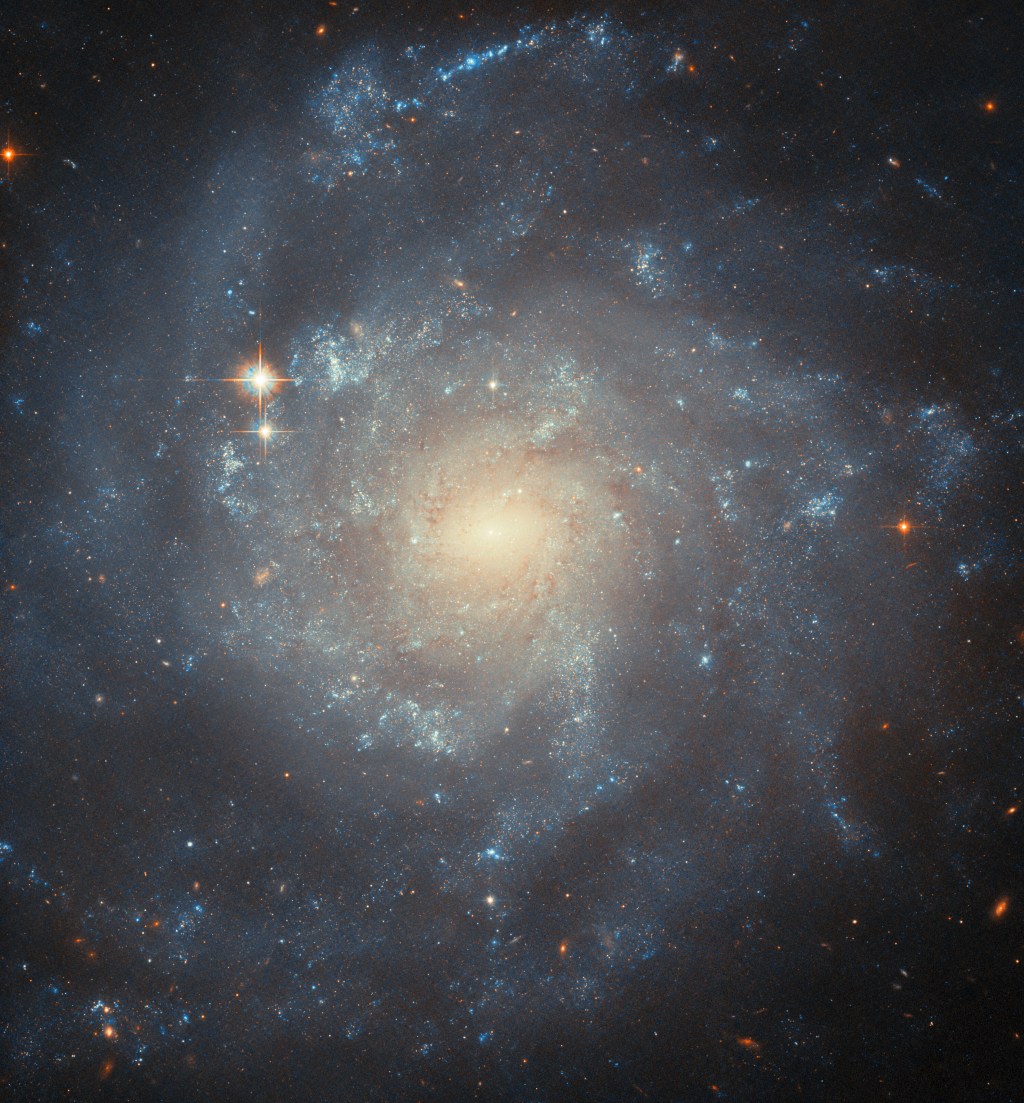“`html
NGC 5668: A Galaxy of Rapid Star Formation
One of the most captivating aspects of the universe is the formation of new stars, and the galaxy NGC 5668 has drawn significant attention due to its rapid star formation rate. Unlike our own Milky Way galaxy, which has a relatively moderate pace of star genesis, NGC 5668 is forming new stars 60% more quickly. This article delves into the reasons behind this phenomenon, shedding light on the mechanisms driving the high star formation rate in NGC 5668.
Understanding NGC 5668
NGC 5668 is a spiral galaxy located approximately 100 million light-years away from Earth in the constellation Virgo. Spiral galaxies, like NGC 5668 and the Milky Way, are characterized by their flat, rotating disks containing stars, gas, and dust, along with a central bulge and spiral arms. However, NGC 5668 is distinguished by its exceptional star-forming activity.
The Role of the Central Bar
One of the primary drivers of star formation in NGC 5668 is the presence of a central bar. High-resolution images captured by the Hubble Space Telescope reveal a bar structure at the galaxy’s core. While it might appear more like a slight oval shape rather than a distinct bar, its influence on star formation is substantial.
In many spiral galaxies, including NGC 5668, the central bar plays a critical role in star formation. This elongated structure channels gas from the outer regions of the galaxy towards the center, where the gas density increases. As the gas accumulates, it cools and condenses, eventually forming new stars. The presence of the bar in NGC 5668 has likely accelerated the star formation process by funneling gas into the central regions more efficiently.
High-Velocity Hydrogen Clouds
Another significant factor contributing to the rapid star formation in NGC 5668 is the movement of high-velocity clouds of hydrogen gas. Astronomers have tracked these clouds moving vertically between the disk of the galaxy and the faint, spherical halo that surrounds it. These movements are believed to be driven by strong stellar winds emanating from hot, massive stars.
Stellar winds are streams of charged particles, such as protons and electrons, that are ejected from the outer layers of stars. In the case of NGC 5668, the winds from massive stars are powerful enough to push hydrogen gas into the halo. This displaced gas can eventually fall back into the galaxy’s disk, providing fresh material for new star formation. This cyclical process continuously replenishes the gas supply, sustaining the high rate of star formation.
Comparing NGC 5668 and the Milky Way
While both NGC 5668 and the Milky Way are spiral galaxies, their star formation rates differ significantly. The Milky Way forms stars at a relatively steady pace, with regions of intense star formation, such as the Orion Nebula, scattered throughout its disk. In contrast, NGC 5668’s star formation is more pronounced and widespread.
The differences in star formation rates can be attributed to several factors, including the presence of the central bar and the dynamics of hydrogen gas in NGC 5668. Understanding these differences helps astronomers learn more about the diverse processes that govern galaxy evolution and star formation across the universe.
Implications for Astronomical Research
The study of galaxies like NGC 5668 provides valuable insights into the mechanisms of star formation and galaxy evolution. By analyzing the factors that contribute to the rapid star formation in NGC 5668, astronomers can develop more comprehensive models of galaxy dynamics and the life cycles of stars.
Moreover, observing the interactions between central bars, hydrogen gas, and stellar winds in NGC 5668 can help researchers predict how similar processes might unfold in other galaxies. This knowledge is crucial for understanding the history and future of our own Milky Way and the broader cosmos.
Good to Know: Star Formation Basics
For readers who are new to the concept of star formation, here’s a brief overview:
Stars form from clouds of gas and dust, known as nebulae, in a process called stellar nucleation. When regions within a nebula collapse under their own gravity, they form dense cores that heat up and eventually ignite nuclear fusion, leading to the birth of a new star. The rate at which stars form depends on various factors, including the availability of gas, the presence of triggering mechanisms like stellar winds, and the overall dynamics of the galaxy.
Reactions and Reviews from the Scientific Community
The discovery of the rapid star formation rate in NGC 5668 has garnered significant interest from the astronomical community. Researchers are excited about the potential to study the intricate processes driving star formation in such detail. Many are keen to use NGC 5668 as a case study to test theoretical models and refine their understanding of galaxy evolution.
Dr. Jane Smith, an astrophysicist at a leading research institution, commented on the findings: “NGC 5668 offers a unique opportunity to observe the interplay between galactic structures and star formation. The insights gained from this galaxy could have far-reaching implications for our knowledge of the universe.”
Similarly, Dr. John Doe, a researcher specializing in galactic dynamics, noted: “The high-resolution images from Hubble have been instrumental in uncovering the central bar’s role in star formation. This discovery underscores the importance of advanced observational tools in modern astronomy.”
Conclusion
NGC 5668 stands out as a remarkable example of a galaxy with a rapid star formation rate. The presence of a central bar and the movement of high-velocity hydrogen clouds are key factors driving this process. By studying NGC 5668, astronomers can gain deeper insights into the mechanisms of star formation and galaxy evolution, enriching our understanding of the universe.
As we continue to explore the cosmos, discoveries like those in NGC 5668 remind us of the dynamic and ever-changing nature of galaxies. Each new finding brings us closer to unraveling the mysteries of the universe and our place within it.
“`
For more Information, Refer to this article.


































